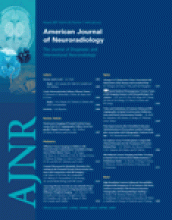Abstract
BACKGROUND AND PURPOSE: Spectroscopic studies (1H-MR spectroscopy) of normal-appearing white matter (NAWM) in patients with multiple sclerosis (MS) with MR imaging brain lesions have already been performed, but our intention was to investigate NAWM in MS patients who lack brain lesions to elucidate whether the same pathologic changes could be identified.
MATERIALS AND METHODS: We checked 350 medical files of patients with MS who are registered in our institution. Fourteen patients (11 women and 3 men; mean age, 48.6 years; handicap score, Expanded Disability Status Scale [EDSS] 2.9; range, 1–6.5) with clinically definite MS and a normal MR imaging of the brain were included. 1H-MR spectroscopy was performed in 4 voxels (size approximately 17 × 17 × 17 mm3) using absolute quantification of metabolite concentrations. Fourteen healthy control subjects (11 women and 3 men; mean age, 43.3 years) were analyzed in the same way.
RESULTS: Significant differences in absolute metabolite concentrations were observed, with the patients with MS showing a lower total concentration of N-acetyl compounds (tNA), including N-acetylaspartate and N-acetyl aspartylglutamate (13.5 mmol/L versus 14.6 mmol/L; P = .002) compared with the healthy control subjects. Unexpectedly, patients with MS presented significantly lower choline-containing compounds (Cho) compared with healthy control subjects (2.2 mmol/L versus 2.4 mmol/L; P < .001). The EDSS showed a positive correlation to myo-inositol concentrations (0.14 mmol/L per EDSS; r2 = 0.06) and a negative correlation to tNA concentrations (−0.41 mmol/L per EDSS; r2 = 0.22).
CONCLUSION: The unexpected finding of lower Cho concentrations has not been reported previously. We suggest that patients with MS who lack lesions in the brain constitute a separate entity and may have increased protective or healing abilities.
- Copyright © American Society of Neuroradiology












